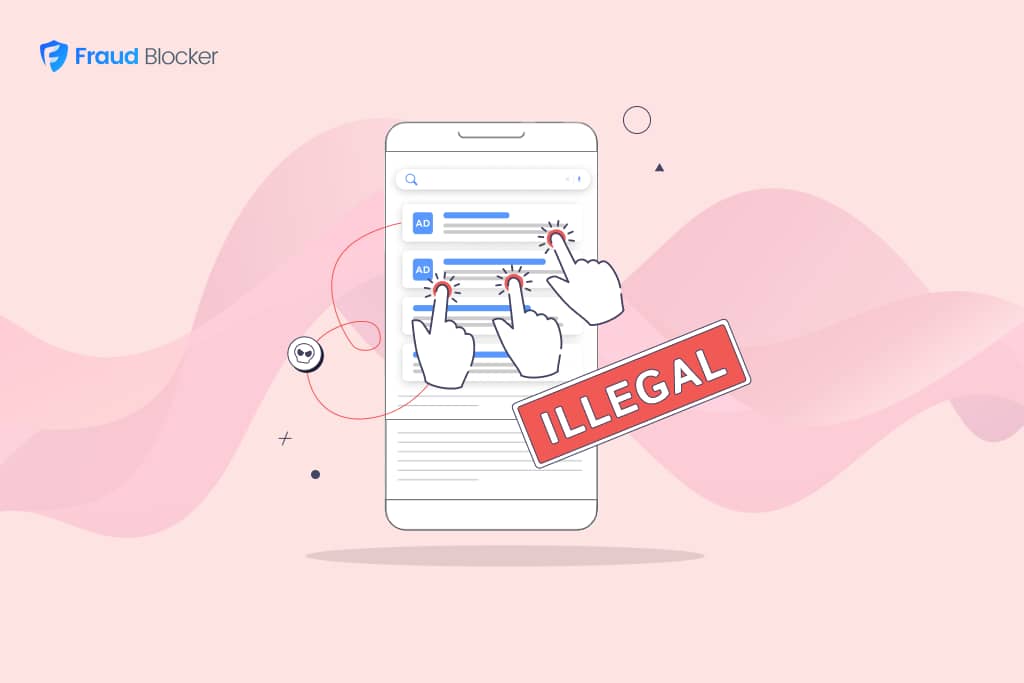
NEW New feature: Verify & block fake emails

We improve your ad performance by blocking click fraud and fake emails

Click fraud is costing advertisers billions in loses. Learn more here.

Click fraud is costing advertisers billions in loses. Learn more here.

Up to 25% of all affiliate traffic is considered fraudulent (source: SearchEngineLand.com)
Affiliate fraud can wreak havoc on your marketing efforts, draining ad spending and eroding trust in your program. What looks like a boost for your business starts costing you much more than you realize.
But what exactly is affiliate fraud, how does it impact your business, and what can you do to stop it? Let’s take a closer look.
Affiliate fraud is any fraudulent or deceptive manipulation of metrics in an affiliate marketing program to earn commissions.
Affiliates typically receive payments based on specific actions such as clicks, leads, or sales they generate for a business. Affiliate fraud occurs when these actions are falsified or generated illegitimately, causing businesses to pay for non-genuine traffic, leads, or sales.
Click fraud is one of the most common forms of affiliate fraud, especially in pay-per-click (PPC) programs, which cost marketers $100B in 2023. Scammers use bots or
click farms to generate fake clicks on ads that will never convert, wasting the marketer’s ad budget.
Scammers may also use techniques like ad stacking, where multiple ads are layered on top of each other, and click injection, which secretly generates clicks via apps.
Learn more about the types of click fraud and how to stop fake clicks.
In click spoofing, a fraudulent publisher joins an advertiser’s affiliate program and sets up deceptive click-tracking. When a user navigates to the publisher’s website without engaging with ads or affiliate links, a click event is still triggered, falsely recording user engagement.
If the user later visits the advertiser’s website organically or through another legitimate source and makes a purchase, the malicious publisher gets credited for the sale despite contributing no real value to it.
Google Ad hijacking involves affiliates bidding on branded keywords and impersonating the brand through fake or cloned websites. These cloned sites mimic the original brand’s website, drive traffic away from the legitimate site, and claim credit for sales.
Ad hijacking and website cloning not only result in fraudulent commissions but can also harm the brand’s reputation.
In URL hijacking, also known as typosquatting, fraudsters register domains that closely resemble popular brand names, capturing traffic from users who mistype the website URL.
Here’s what this could look like:
Or this:
Once visitors land on these fake sites, they unknowingly click on affiliate links, generating commissions for the hijacker without providing any value to the brand.
Lead fraud involves generating fake or low-quality leads, by submitting incorrect or fabricated information. Affiliates might use bots or stolen data to create these leads, tricking businesses into thinking they’re getting valuable prospects.
In some cases, scammers might even redirect legitimate traffic to generate fraudulent leads. While these fake leads might increase numbers temporarily, they rarely convert into real sales.
In sale and transaction fraud, affiliates use stolen or fake credit cards to make purchases through their own affiliate links, earning commissions. Some affiliates manipulate tracking data to look like legitimate sales are happening, but these transactions eventually lead to chargebacks or refunds.
Cookie stuffing is a sneaky tactic where affiliates place tracking cookies on a user’s device without their knowledge, allowing the affiliate to claim commissions for purchases the user didn’t intend to credit. Many types of affiliate fraud operate in a legal gray area, but this one is established as illegal, as an eBay affiliate was sentenced to 5 months in prison for violating eBay’s TOS with a cookie-stuffing scheme.
Detecting affiliate marketing fraud is crucial for protecting your business from wasted ad spending and maintaining the integrity of your affiliate program. Fraud can be subtle and often hidden in the data, so you need a proactive approach.
Here are key strategies to help you identify fraudulent activities before they cause significant damage.
Many types of affiliate fraud aren’t illegal unless affiliates break specific terms and conditions. Setting up strict rules based on the different types of fraud can help discourage malicious actors and hold them accountable when caught.
Here are some helpful rules to get started:
One of the first signs of affiliate fraud is abnormal traffic behavior. You know your site best, so watch for sudden spikes in traffic or clicks that don’t match your usual patterns.
If an affiliate suddenly generates a large volume of clicks without a corresponding increase in conversions, it could indicate fake traffic, such as bots or click farms.
A low conversion rate combined with high traffic from a particular affiliate is a red flag. If an affiliate sends many visitors to your site, but very few of them convert into customers, it’s worth investigating.
Learn more about conversion tracking here.
Lead fraud often involves fake or low-quality leads that don’t convert into sales. Screen for this by checking the information provided; is it accurate and relevant to your target audience?
Also, pay attention to repeated or incomplete information because they are common fraud indicators. Poor lead quality is a strong sign that something isn’t right with the affiliate’s traffic sources.
Fraudulent affiliates often use unusual traffic sources or obscure referral links. Regularly review where your traffic is coming from. If you see traffic from unexpected locations or unconnected sources, it’s worth further investigation.
This is particularly important for detecting tactics like URL hijacking, where fraudsters redirect traffic from lookalike domains.
Unusual payment behaviors can signal sale or transaction fraud. Watch for a surge in high-value purchases within a short time frame, especially if the billing and shipping addresses don’t match. High refund rates tied to specific affiliates can also mean fraudulent transactions that exploit your commission structure.
Unusually high performance from a single affiliate can sometimes be too good to be true. If an affiliate suddenly outperforms all others by a wide margin, it’s worth digging deeper.
Investigate whether their traffic sources, conversion rates, and sales match the typical patterns you see across your program. This helps uncover potential fraud like cookie stuffing or ad hijacking.
Unauthorized PPC ads on branded keywords can impersonate your brand, hijack your commissions, and even be used for cookie stuffing.
Restricting affiliates from bidding on your brand name and related terms can prevent this and ensure your legitimate PPC campaigns remain the primary source of brand-driven traffic. You can also monitor search results to spot any affiliates violating this rule and use tools that alert you to brand bidding violations.
Click fraud is an expensive type of affiliate fraud, costing marketers Billions per year. When fraudulent clicks from bots, malicious actors, or competitors are generated, they rack up your ad spend without real engagement or sales. Click fraud can waste your ad budgets, skew data, and even damage affiliate relationships.
Click fraud prevention tools like Fraud Blocker are designed to identify unusual traffic patterns and stop malicious activities. Using a specialized solution as an extra layer of defense increases the likelihood that your advertising budget will be spent effectively on real users rather than fraudulent, non-converting traffic.
Start a 7-day free trial to see Fraud Blocker can help protect your campaigns


